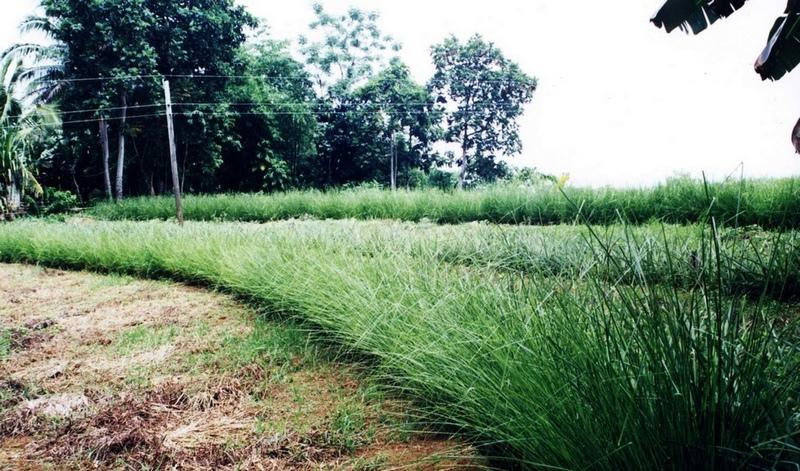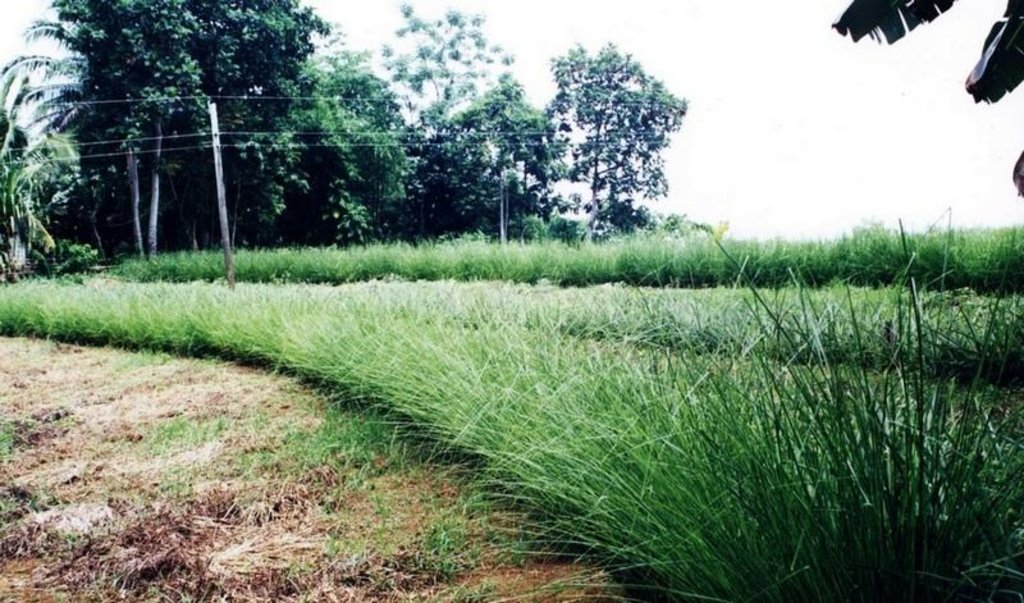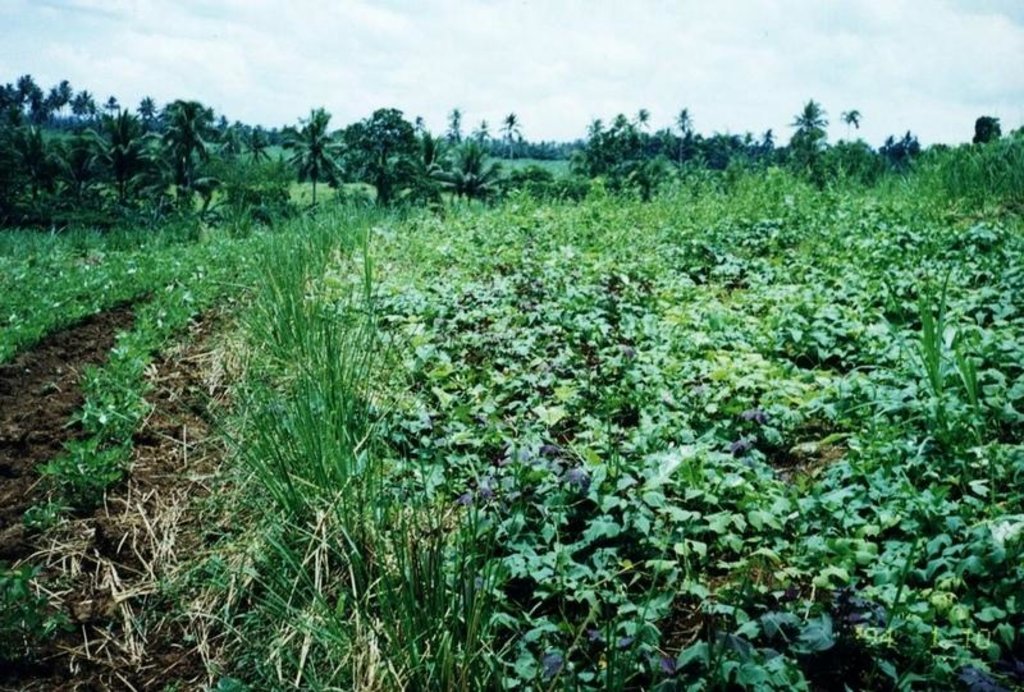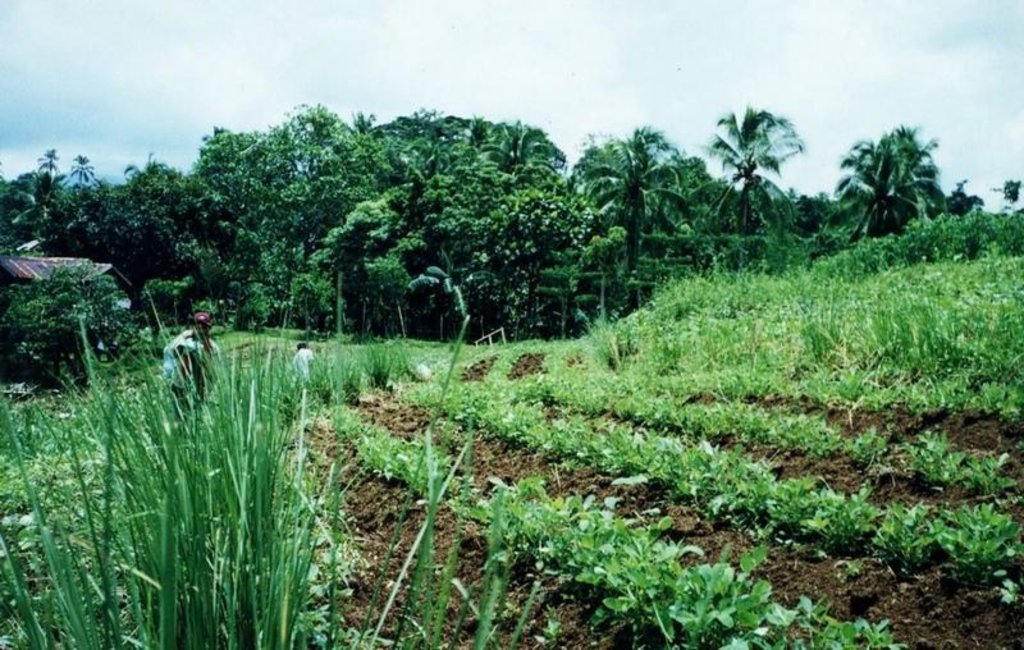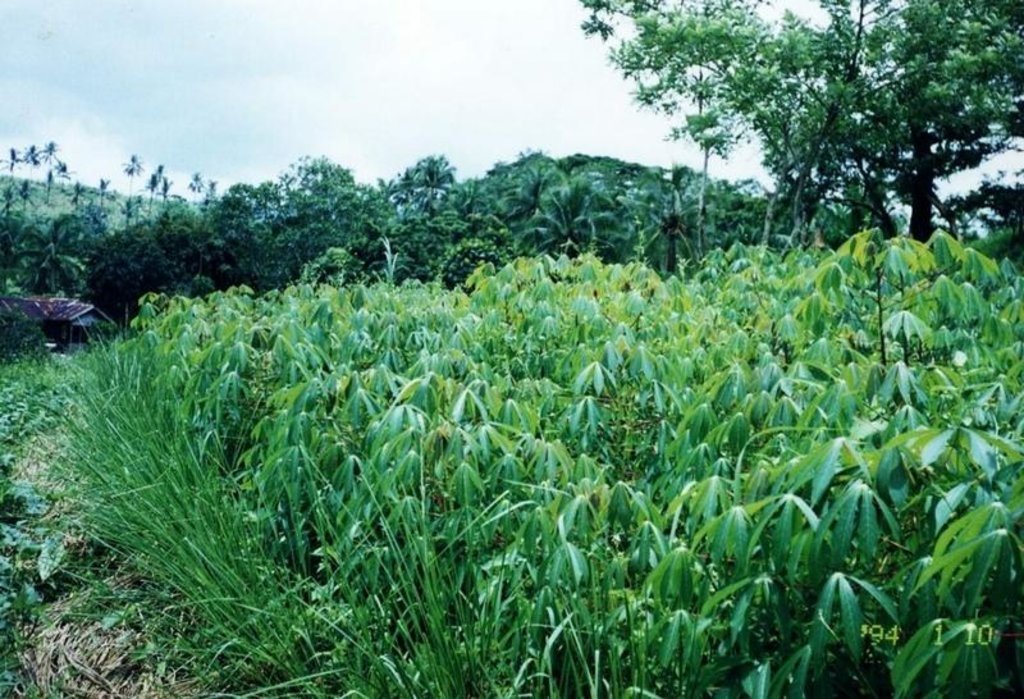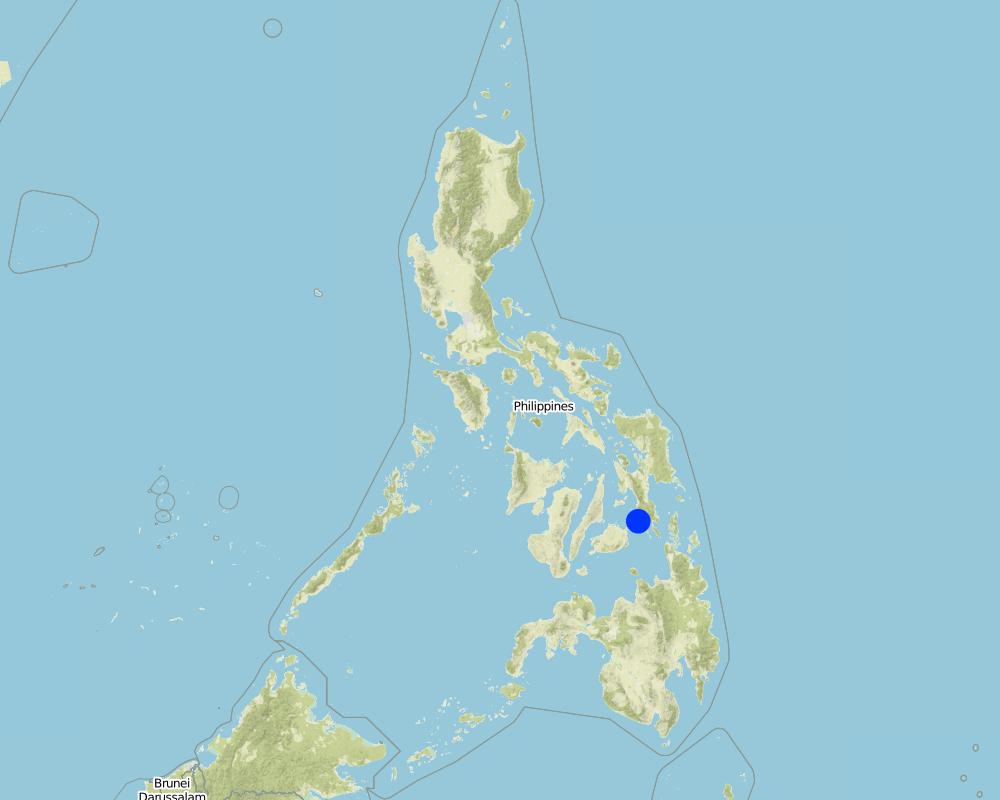Vetiver grass system or Vetiver grass technology [菲律宾]
- 创建:
- 更新:
- 编制者: Philippine Overview of Conservation Approaches and Technologies
- 编辑者: –
- 审查者: Deborah Niggli, Alexandra Gavilano
Mora, Moras, Amora and Modas in the different regions in the Philippines
technologies_1423 - 菲律宾
查看章节
全部展开 全部收起1. 一般信息
1.2 参与该技术评估和文件编制的资源人员和机构的联系方式
1.3 关于使用通过WOCAT记录的数据的条件
编制者和关键资源人员接受有关使用通过WOCAT记录数据的条件。:
是
1.4 所述技术的可持续性声明
这里所描述的技术在土地退化方面是否存在问题,导致无法被认为是一种可持续的土地管理技术?:
否
2. SLM技术的说明
2.1 技术简介
技术定义:
Vetiver grass used as contour hedgerows in sloping agricultural land used for annual crops.
2.2 技术的详细说明
说明:
Vetiver grass is easy to propagate and establish as hedgerow. It is adopted to a wide range of soil and climatic condition. When planted correctly, vetiver grass will form a dense permanent hedge in one year. It has a strong root system that penetrates and binds the soil. Vetiver grass is perennial and requires minimal maintenance. It will not spread to the alleys since it does not multiply by rhizomes nor from seeds. Compare with other grass, it does not compete much with the crops it is protecting. Vetiver crown is below the ground surface which helps protect the plant against fire and overgrazing. Its leaves and roots are resistannt to insects and diseases. Vetiver can withstand, drought, flood and long period of water logging.
2.3 技术照片
2.5 已应用该技术的、本评估所涵盖的国家/地区/地点
国家:
菲律宾
区域/州/省:
Leyte
有关地点的进一步说明:
Leyte
具体说明该技术的分布:
- 均匀地分布在一个区域
如果技术均匀分布在一个区域,则指定覆盖的区域(单位为平方千米):
0.8
注释:
Total area covered by the SLM Technology is 0.8 km2.
The technology was first used to stabilize/strengthen rice paddy dikes/levees. In the project, the technology is used by small upland farmers to control soil erosion by water.
Map
×2.6 实施日期
如果不知道确切的年份,请说明大概的日期:
- 50多年前(传统)
2.7 技术介绍
详细说明该技术是如何引入的:
- 通过项目/外部干预
注释(项目类型等):
As an SWC, the technology is supported and promoted by the World Bank through the Vetiver Network involving several Asian countries.
3. SLM技术的分类
3.1 该技术的主要目的
- 减少、预防、恢复土地退化
3.2 应用该技术的当前土地利用类型

农田
- 一年一作
年作 - 具体指明作物:
- 谷物类 - 玉米
- 豆科牧草和豆类 - 其他
- vetiver
每年的生长季节数:
- 2
具体说明:
Longest growing period in days: 110, Longest growing period from month to month: Apr - Dec
注释:
Major land use problems (compiler’s opinion): Annual cropping of corn and othrer crops in hillyland using plow which makes the soil vulnerable to erosion.
Major land use problems (land users’ perception): Declining productivity and increasing input (fertilizer) to maintain yield.
Type of cropping system and major crops comments: Two crops of corn with legumes. However, not all farmers practice two croppings
3.4 供水
该技术所应用土地的供水:
- 雨养
3.5 该技术所属的SLM组
- 横坡措施
3.6 包含该技术的可持续土地管理措施

植物措施
- V2:草和多年生草本植物
注释:
Type of vegetative measures: aligned: -contour
3.7 该技术强调的主要土地退化类型

土壤水蚀
- Wt:表土流失/地表侵蚀
- Wg:冲沟侵蚀/沟蚀

化学性土壤退化
- Cn:肥力下降和有机质含量下降(非侵蚀所致)
3.8 防止、减少或恢复土地退化
具体数量名该技术与土地退化有关的目标:
- 防止土地退化
- 减少土地退化
4. 技术规范、实施活动、投入和成本
4.1 该技术的技术图纸
技术规范(与技术图纸相关):
Technical knowledge required for field staff / advisors: moderate
Technical knowledge required for land users: moderate
Main technical functions: control of dispersed runoff: retain / trap, reduction of slope length
Secondary technical functions: control of concentrated runoff: retain / trap
Aligned: -contour
Vegetative material: G : grass
Number of plants per (ha): 10-12 till
Vertical interval between rows / strips / blocks (m): 3
Spacing between rows / strips / blocks (m): 6
Vertical interval within rows / strips / blocks (m): 0.15
Grass species: Vetiver
Slope (which determines the spacing indicated above): 18.00%
If the original slope has changed as a result of the Technology, the slope today is (see figure below): 8.00%
Gradient along the rows / strips: 3.00%
4.2 有关投入和成本计算的一般信息
其它/国家货币(具体说明):
Peso
如相关,注明美元与当地货币的汇率(例如1美元=79.9巴西雷亚尔):1美元=:
50.0
注明雇用劳工的每日平均工资成本:
2.00
4.3 技术建立活动
| 活动 | 时间(季度) | |
|---|---|---|
| 1. | Planting vetiver grass along the contour | Before planting of corn |
| 2. | Replacement/replanting of gaps | land preparation |
4.4 技术建立所需要的费用和投入
| 对投入进行具体说明 | 单位 | 数量 | 单位成本 | 每项投入的总成本 | 土地使用者承担的成本% | |
|---|---|---|---|---|---|---|
| 劳动力 | labour | ha | 1.0 | 50.0 | 50.0 | 100.0 |
| 植物材料 | seedlings | ha | 1.0 | 100.0 | 100.0 | 100.0 |
| 技术建立所需总成本 | 150.0 | |||||
| 技术建立总成本,美元 | 3.0 | |||||
4.5 维护/经常性活动
| 活动 | 时间/频率 | |
|---|---|---|
| 1. | pruning | land preparation /once |
4.6 维护/经常性活动所需要的费用和投入(每年)
| 对投入进行具体说明 | 单位 | 数量 | 单位成本 | 每项投入的总成本 | 土地使用者承担的成本% | |
|---|---|---|---|---|---|---|
| 劳动力 | labour | ha | 1.0 | 20.0 | 20.0 | 100.0 |
| 技术维护所需总成本 | 20.0 | |||||
| 技术维护总成本,美元 | 0.4 | |||||
注释:
Distance of grass strips, distance of planting within strips and frequency of maintenance (trimming).
4.7 影响成本的最重要因素
描述影响成本的最决定性因素:
Labor is the most important factor (establishing contour, land preparation and planting). Planting materials can be asked for free from other farmers.
5. 自然和人文环境
5.1 气候
年降雨量
- < 250毫米
- 251-500毫米
- 501-750毫米
- 751-1,000毫米
- 1,001-1,500毫米
- 1,501-2,000毫米
- 2,001-3,000毫米
- 3,001-4,000毫米
- > 4,000毫米
农业气候带
- 潮湿的
Thermal climate class: tropics
5.2 地形
平均坡度:
- 水平(0-2%)
- 缓降(3-5%)
- 平缓(6-10%)
- 滚坡(11-15%)
- 崎岖(16-30%)
- 陡峭(31-60%)
- 非常陡峭(>60%)
地形:
- 高原/平原
- 山脊
- 山坡
- 山地斜坡
- 麓坡
- 谷底
垂直分布带:
- 0-100 m a.s.l.
- 101-500 m a.s.l.
- 501-1,000 m a.s.l.
- 1,001-1,500 m a.s.l.
- 1,501-2,000 m a.s.l.
- 2,001-2,500 m a.s.l.
- 2,501-3,000 m a.s.l.
- 3,001-4,000 m a.s.l.
- > 4,000 m a.s.l.
5.3 土壤
平均土层深度:
- 非常浅(0-20厘米)
- 浅(21-50厘米)
- 中等深度(51-80厘米)
- 深(81-120厘米)
- 非常深(> 120厘米)
土壤质地(表土):
- 中粒(壤土、粉土)
表土有机质:
- 低(<1%)
5.6 应用该技术的土地使用者的特征
生产系统的市场定位:
- 生计(自给)
- 混合(生计/商业)
非农收入:
- 收入的10-50%
相对财富水平:
- 贫瘠
- 平均水平
机械化水平:
- 手工作业
- 畜力牵引
说明土地使用者的其他有关特征:
Population density: 50-100 persons/km2
Annual population growth: 2% - 3%
30% of the land users are rich and own 10% of the land.
20% of the land users are average wealthy and own 50% of the land.
50% of the land users are poor and own 40% of the land.
Off-farm income specification: Trading, carpentry, hired labour, overseas employment
5.7 应用该技术的土地使用者使用的平均土地面积
- < 0.5 公顷
- 0.5-1 公顷
- 1-2 公顷
- 2-5公顷
- 5-15公顷
- 15-50公顷
- 50-100公顷
- 100-500公顷
- 500-1,000公顷
- 1,000-10,000公顷
- > 10,000公顷
5.8 土地所有权、土地使用权和水使用权
土地所有权:
- 个人,未命名
- 个人,有命名
土地使用权:
- 个人
6. 影响和结论性说明
6.1 该技术的现场影响
社会经济效应
生产
作物生产
土地管理
注释/具体说明:
hedgerow restricted mobility
收入和成本
工作量
注释/具体说明:
during establishment/maintenance
社会文化影响
SLM/土地退化知识
注释/具体说明:
strong awareness
生态影响
水循环/径流
地表径流
SLM之前的数量:
60
SLM之后的数量:
20
土壤
土壤水分
注释/具体说明:
better infiltration
土壤流失
SLM之前的数量:
50
SLM之后的数量:
10
注释/具体说明:
almost nil erosion
其它生态影响
Soil fertility
注释/具体说明:
increase organic matter
6.2 该技术的场外影响已经显现
下游淤积
注释/具体说明:
almost zero erosion
6.4 成本效益分析
技术收益与技术建立成本相比如何(从土地使用者的角度看)?
短期回报:
中性/平衡
长期回报:
积极
技术收益与技术维护成本/经常性成本相比如何(从土地使用者的角度看)?
短期回报:
积极
长期回报:
积极
6.5 技术采用
在所有采用这项技术的人当中,有多少人是自发的,即未获得任何物质奖励/付款?:
- 0-10%
注释:
2% of land user families have adopted the Technology with external material support
5% of land user families have adopted the Technology without any external material support
50 land user families have adopted the Technology without any external material support
There is a moderate trend towards spontaneous adoption of the Technology. Farmers have recognized the benefit of the technology. Even the Local Government Units (LGU's) are supportive of the technology and have adapted it as one of their banner programs.
6.7 该技术的优点/长处/机会
| 土地使用者眼中的长处/优势/机会 |
|---|
| Easy to establish and maintain |
| 编制者或其他关键资源人员认为的长处/优势/机会 |
|---|
| Easy to establish and maintain |
| Vetiver grows well even in fertile soil |
6.8 技术的弱点/缺点/风险及其克服方法
| 土地使用者认为的弱点/缺点/风险 | 如何克服它们? |
|---|---|
| Prevents easier mobility within the farm | Proper farm design |
| Sanctuary for pests | Cleanliness, rat eradication, etc. |
| 编制者或其他关键资源人员认为的弱点/缺点/风险 | 如何克服它们? |
|---|---|
| Prevents easier mobility within the farm | Appropriate farm lay-out |
| Vetiver grass can serve as sanctuary for pests (rats, snakes, etc) | Cleanliness |
7. 参考和链接
7.1 信息的方法/来源
- 实地考察、实地调查
- 与土地使用者的访谈
(现场)数据是什么时候汇编的?:
02/08/2002
7.2 参考可用出版物
标题、作者、年份、ISBN:
Vetiver for Soil Erosion Control
可以从哪里获得?成本如何?
Vetiver Network Philippines, Farm and Resource Management Institute, VISCA, Baybay, Leyte, Philippines
标题、作者、年份、ISBN:
Vetiver Grass the Hedge Against Erosion
可以从哪里获得?成本如何?
World Bank, Washington D.C., USA
链接和模块
全部展开 全部收起链接
无链接
模块
无模块


